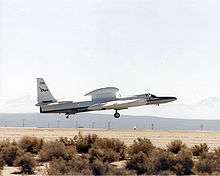Airborne Science Program
NASA's Airborne Science Program is administered from the NASA Neil A. Armstrong Flight Research Center, in Edwards, California. The program supports the sub-orbital flight requirements of NASA's Earth Science Enterprise. Dryden maintains and operates two ER-2 high-altitude "satellite simulator" aircraft and a DC-8 which is specially configured as a "flying laboratory".

The scientific disciplines that employ these aircraft include Earth sciences, astronomy, atmospheric chemistry, climatology, oceanography, archeology, ecology, forestry, geography, geology, hydrology, meteorology, volcanology and biology. The DC-8 and ER-2 are also important tools for the development of sensors intended to fly aboard future Earth-observing satellites, and to validate and calibrate the sensors which are used onboard satellites which currently orbit the Earth.
Media
References
External links
- "NASA Airborne Science Program". NASA. Archived from the original on 29 September 2005. Retrieved October 18, 2005.